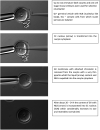Nucleus reprogramming/remodeling through selective enucleation (SE) of immature oocytes and zygotes: a nucleolus point of view
- PMID: 35431279
- PMCID: PMC9184824
- DOI: 10.1262/jrd.2022-004
Nucleus reprogramming/remodeling through selective enucleation (SE) of immature oocytes and zygotes: a nucleolus point of view
Abstract
It is now approximately 25 years since the sheep Dolly, the first cloned mammal where the somatic cell nucleus from an adult donor was used for transfer, was born. So far, somatic cell nucleus transfer, where G1-phase nuclei are transferred into cytoplasts obtained by enucleation of mature metaphase II (MII) oocytes followed by the activation of the reconstructed cells, is the most efficient approach to reprogram/remodel the differentiated nucleus. In general, in an enucleated oocyte (cytoplast), the nuclear envelope (NE, membrane) of an injected somatic cell nucleus breaks down and chromosomes condense. This condensation phase is followed, after subsequent activation, by chromatin decondensation and formation of a pseudo-pronucleus (i) whose morphology should resemble the natural postfertilization pronuclei (PNs). Thus, the volume of the transferred nuclei increases considerably by incorporating the content released from the germinal vesicles (GVs). In parallel, the transferred nucleus genes must be reset and function similarly as the relevant genes in normal embryo reprogramming. This, among others, covers the relevant epigenetic modifications and the appropriate organization of chromatin in pseudo-pronuclei. While reprogramming in SCNT is often discussed, the remodeling of transferred nuclei is much less studied, particularly in the context of the developmental potential of SCNT embryos. It is now evident that correct reprogramming mirrors appropriate remodeling. At the same time, it is widely accepted that the process of rebuilding the nucleus following SCNT is instrumental to the overall success of this procedure. Thus, in our contribution, we will mostly focus on the remodeling of transferred nuclei. In particular, we discuss the oocyte organelles that are essential for the development of SCNT embryos.
Keywords: Nucleus; Remodeling; Reprogramming; Selective enucleation.
Conflict of interest statement
The authors declare no competing or financial interests.
Figures





Similar articles
-
Somatic cell nuclear transfer (SCNT) in mammals: the cytoplast and its reprogramming activities.Adv Exp Med Biol. 2007;591:93-102. doi: 10.1007/978-0-387-37754-4_7. Adv Exp Med Biol. 2007. PMID: 17176557 Review.
-
Dissecting the role of the germinal vesicle nuclear envelope and soluble content in the process of somatic cell remodelling and reprogramming.J Reprod Dev. 2019 Oct 23;65(5):433-441. doi: 10.1262/jrd.2019-017. Epub 2019 Aug 18. J Reprod Dev. 2019. PMID: 31423000 Free PMC article.
-
Do the Cytoplast and Nuclear Material of Germinal Vesicle Oocyte Support Developmental Competence Upon Reconstruction with Embryonic/Somatic Nucleus.Cell Reprogram. 2019 Aug;21(4):163-170. doi: 10.1089/cell.2019.0032. Epub 2019 Jul 16. Cell Reprogram. 2019. PMID: 31313935 Review.
-
Single nucleolus precursor body formation in the pronucleus of mouse zygotes and SCNT embryos.PLoS One. 2018 Aug 20;13(8):e0202663. doi: 10.1371/journal.pone.0202663. eCollection 2018. PLoS One. 2018. PMID: 30125305 Free PMC article.
-
Development of porcine tetraploid somatic cell nuclear transfer embryos is influenced by oocyte nuclei.Cell Biol Int. 2016 Feb;40(2):214-22. doi: 10.1002/cbin.10554. Epub 2015 Nov 24. Cell Biol Int. 2016. PMID: 26503330
References
-
- Ogura A, Matoba S, Inoue K. 25th ANNIVERSARY OF CLONING BY SOMATIC-CELL NUCLEAR TRANSFER: Epigenetic abnormalities associated with somatic cell nuclear transfer. Reproduction 2021; 162: F45–F58. - PubMed
-
- Lindahl T. Instability and decay of the primary structure of DNA. Nature 1993; 362: 709–715. - PubMed

